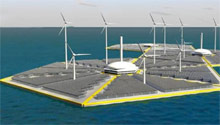Efforts to develop a massive environmentally friendly power plant combining photovoltaic generators and windmills that will float on the sea are primmed to spark a revolution in clean power, according to a team of scientists at Kyushu University.
The planned plant will measure 1.25 Miles by .5 Miles and will be equipped with light-emitting diodes that shine light into the sea to promote seaweed growth, which in turn will absorb carbon dioxide and attract fish.
The team began testing the floating base for the generator at a research facility in July.
"We'll be able to put [the new generator] to practical use in three years," predicted Toshiaki Ota, a professor emeritus at the university who leads the team.
The plant will comprise hexagonal floating units that support a length of netting on which wind-power generators and photovoltaic generators measuring six square meters will be placed.
About 200,000 photovoltaic generator units are to be placed about a meter apart on the netting, with the hexagonal units positioned at both ends. The units have a channel running through them to allow seawater to pass through.
Each group of units will generate about 300,000 kilowatts of electricity, which means the generating capacity of the three planned sets will be equal to that of a nuclear power reactor.
The cost-to-power-generation rate of the new plant is about $650 to $1300 per kilowatt, considerably cheaper than the approximately $1850 per kilowatt for constructing a nuclear power plant. Only personnel and maintenance costs are required to operate the new plant.
To maintain the electricity-generating capacity of the photovoltaic generators, deep-sea water will be brought to the surface by electric pumps powered by wind turbines and poured over the surface of the plant. Deep-sea water is mineral rich, so drawing it up to the surface is expected to help the growth of seaweed under the plant. The LEDs also will emit a type of light that promotes phytoplankton growth.
The hexagonal units are to be made of concrete and reinforced with a new lightweight metal developed by Ota that is 10 times more rust-resistant than steel.
The Coastal Development Institute of Technology, affiliated with the Construction and Transport Ministry, has already begun evaluating the performance of the rectangular floating units.
A test using a model plant also is planned.
"The new generating units also could be used in an inland reservoir," Ota said. "They can be used to manufacture hydrogen--CO2-free fuel--by electrolysis."

